class: center, middle, inverse, title-slide # Guest lecture: Genomic Prediction ## FREC5164 Population Genomics ### Gota Morota <br /><a href="http://morotalab.org/">http://morotalab.org/</a> <br /> ### 4/7/2020 --- class: inverse, center, middle # Quantitative Genetics -- Analysis of complex or multifactorial traits -- All genes affect all traits - the question is by how much? -- Infinitesimal model -- Quasi-infinitesimal model, Oligogenic model --- # Complex traits <img src="phenotype-plant.png" width=800 height=530> --- # Regression model Galton (1886). Regression towards mediocrity in hereditary stature "<img src="galton1886.png" width=600 height=380> --- # Genetic values Quantitative genetic model: `\begin{align*} \mathbf{y} &= \mathbf{g} + \boldsymbol{\epsilon} \\ \end{align*}` where `\(\mathbf{y}\)` is the vector of observed phenotypes, `\(\mathbf{g}\)` is the vector of genetic values, and `\(\boldsymbol{\epsilon}\)` is the vector of residuals. Example: | Plant ID | y | g | e | | ------------- |:-------------:| -----:|------| | 1 | 10 | ? | ? | | 2 | 7 | ? | ? | | 3 | 12 | ? | ? | --- # Genetic values Quantitative genetic model: `\begin{align*} \mathbf{y} &= \mathbf{g} + \boldsymbol{\epsilon} \\ \end{align*}` where `\(\mathbf{y}\)` is the vector of observed phenotypes, `\(\mathbf{g}\)` is the vector of genetic values, and `\(\boldsymbol{\epsilon}\)` is the vector of residuals. Example: | Plant ID | y | g | e | | ------------- |:-------------:| -----:|------| | 1 | 10 | 5 | 5 | | 2 | 7 | 6 | 1 | | 3 | 12 | 2 | 10 | -- Phenotypes can be observed and measured but genotypic and additive genetic effects cannot --- # Conventional Phenotyping 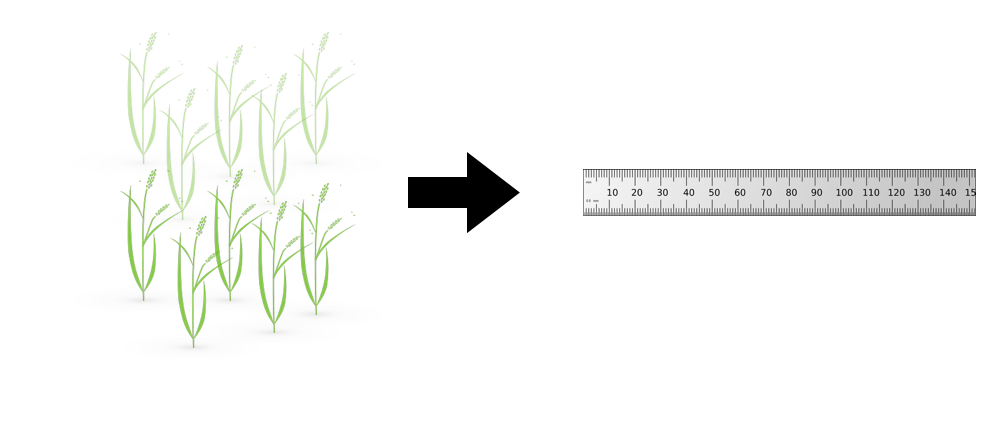 .pull-left[ - labor intensive - prone to measurement error ] .pull-right[ <iframe src="https://giphy.com/embed/Jk4ZT6R0OEUoM" width="500" height="160" frameBorder="0" class="giphy-embed" allowFullScreen></iframe><p><a href="https://giphy.com/gifs/Jk4ZT6R0OEUoM">via GIPHY</a></p> ] --- # Genomic information (e.g., SNPs) 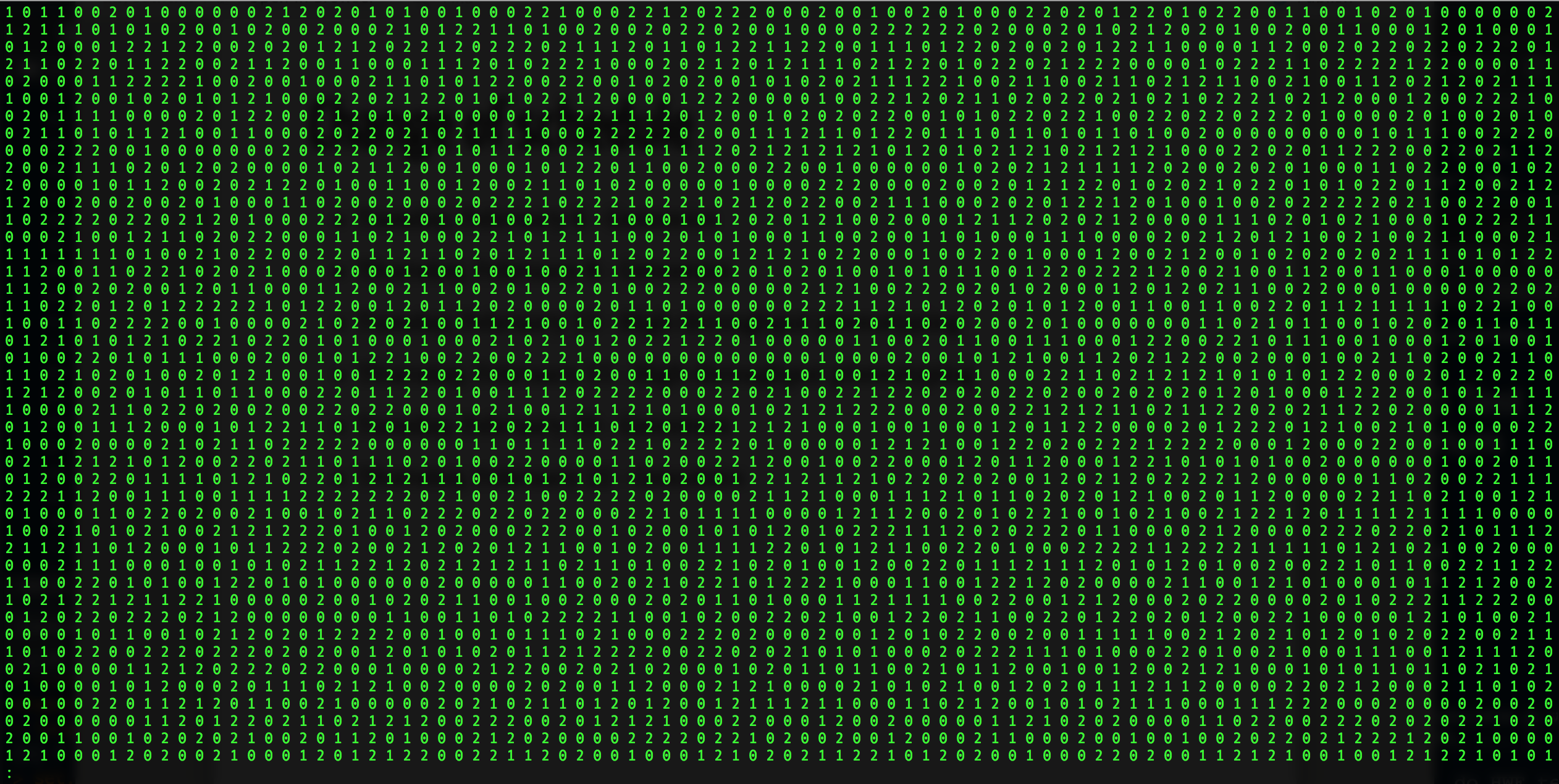 .center[Repeat of numbers 0, 1, and 2] --- # Quantitative genetics Connecting phenotypic data with genomic information<center> <div> <img src="plant.png" width=200 height=100> = <img src="SNPs.png" width=200 height=100> + error </div> </center> `\begin{align*} \mathbf{y} &= \mathbf{g} + \boldsymbol{\epsilon} \\ &\approx \mathbf{W}\mathbf{a} + \boldsymbol{\epsilon} \end{align*}` We approximate unknown `\(\mathbf{g}\)` with `\(\mathbf{Wa}\)`. `\begin{align*} \underbrace{\begin{bmatrix} y_1\\ y_2\\ \vdots \\ y_n\end{bmatrix}}_{n \times 1} &= \underbrace{\begin{bmatrix} w_{11} & w_{12} & \cdots & w_{1m} \\ w_{21} & w_{22} & \cdots & w_{2m} \\ \vdots & \vdots & \ddots & \vdots \\ w_{n1} & w_{n2} & \cdots & w_{nm} \end{bmatrix}}_{n \times m} \quad \underbrace{\begin{bmatrix} a_1\\ a_2\\ \vdots \\ a_m\end{bmatrix}}_{m \times 1} +\underbrace{\begin{bmatrix} \epsilon_1\\ \epsilon_2\\ \vdots \\ \epsilon_m\end{bmatrix}}_{n \times 1} \end{align*}` where `\(n\)` is the number of individuals (e.g., accessions) and `\(m\)` is the number of SNPs. --- # Precision agriculture using advanced technologies 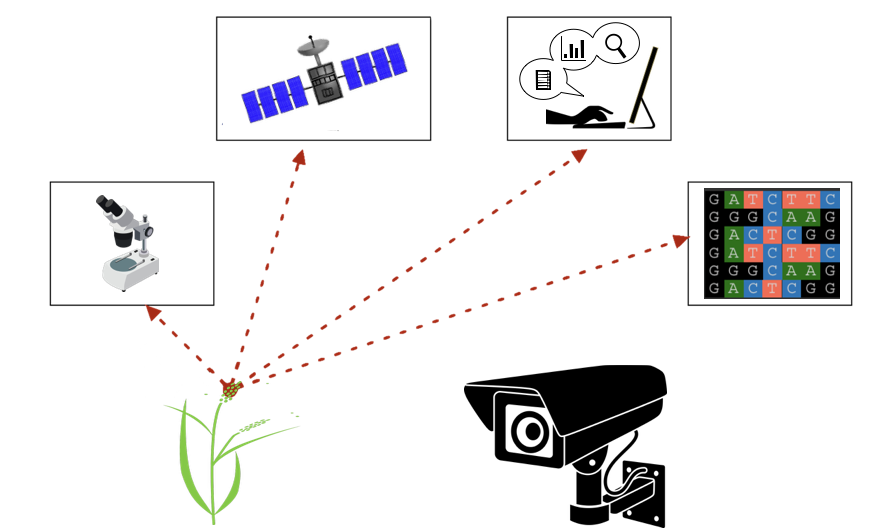 --- # Precision (digital) phenotyping 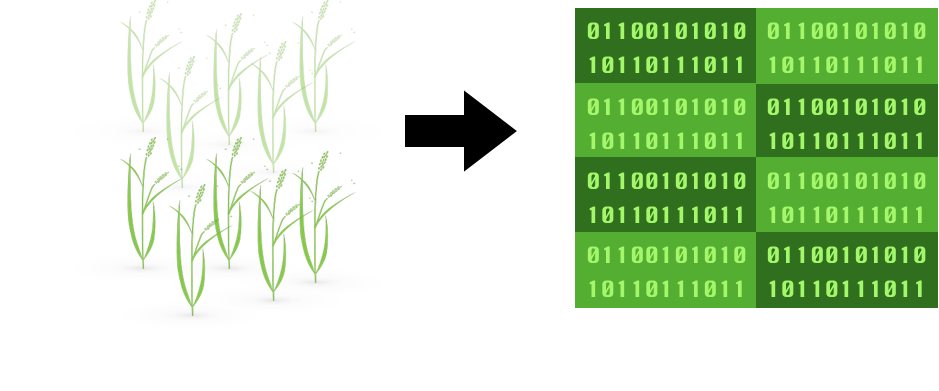 .pull-left[ - automated process - less labor intensive - less prone to measurement error ] .pull-right[ <iframe src="https://giphy.com/embed/wW95fEq09hOI8" width="400" height="160" frameBorder="0" class="giphy-embed" allowFullScreen></iframe><p><a href="https://giphy.com/gifs/chihuahua-funny-cute-wW95fEq09hOI8">via GIPHY</a></p> ] --- # Image phenotypes   .center[Image data] --- # High-throughput phenomics .pull-left[ <div align="left"> <iframe src="https://innovate.unl.edu/video/leasing-options/greenhouse-innovation-center.mp4" width="250" height="150" frameBorder="0" class="giphy-embed" allowFullScreen></iframe><p><a href="https://innovate.unl.edu/greenhouse-innovation-center">UNL Greenhouse Innovation Center</a> </p> </div> <div align="left"> <iframe width="260" height="200" src="https://www.youtube.com/embed/wor4BFjbIyI?rel=0" frameborder="0" allow="autoplay; encrypted-media" allowfullscreen></iframe> <p><a href="https://www.youtube.com/watch?v=wor4BFjbIyI">Spidercam</a> </div> ] .pull-right[ <div align="right"> <img src="https://www.frontiersin.org/files/Articles/254051/fpls-08-00421-HTML/image_m/fpls-08-00421-g002.jpg" width=400 height=400><p>Unmanned aerial vehicle<a href="https://www.frontiersin.org/articles/10.3389/fpls.2017.00421/full"> (Watanabe et al. 2017)</a> </div> ] --- # Automated image-based phenomics facility 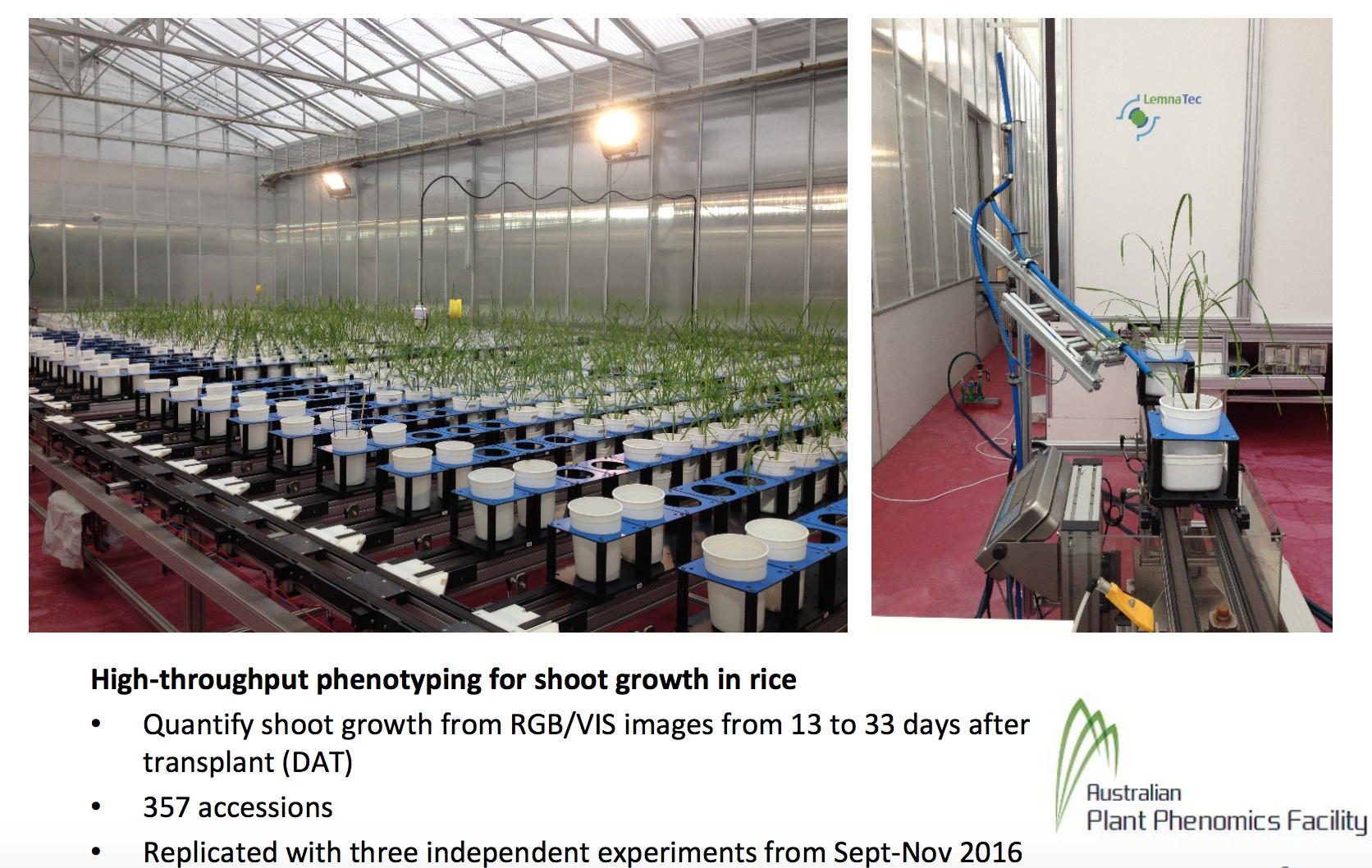 --- # Automated high-throughput phenotyping <iframe width="700" height="500" src="https://www.youtube.com/embed/JWNoQ3w-KbY" frameborder="0" allow="accelerometer; autoplay; encrypted-media; gyroscope; picture-in-picture" allowfullscreen></iframe> --- # Quantitative genetics Connecting image data with genomic information <center> <div> <img src="plant_01.png" width=100 height=100> = <img src="SNPs.png" width=100 height=100> + error </div> </center> `\begin{align*} \mathbf{y} &= \mathbf{g} + \boldsymbol{\epsilon} \\ &\approx \mathbf{W}\mathbf{a} + \boldsymbol{\epsilon} \end{align*}` We approximate unknown `\(\mathbf{g}\)` with `\(\mathbf{Wa}\)`. `\begin{align*} \underbrace{\begin{bmatrix} y_1\\ y_2\\ \vdots \\ y_n\end{bmatrix}}_{n \times 1} &= \underbrace{\begin{bmatrix} w_{11} & w_{12} & \cdots & w_{1m} \\ w_{21} & w_{22} & \cdots & w_{2m} \\ \vdots & \vdots & \ddots & \vdots \\ w_{n1} & w_{n2} & \cdots & w_{nm} \end{bmatrix}}_{n \times m} \quad \underbrace{\begin{bmatrix} a_1\\ a_2\\ \vdots \\ a_m\end{bmatrix}}_{m \times 1} +\underbrace{\begin{bmatrix} \epsilon_1\\ \epsilon_2\\ \vdots \\ \epsilon_m\end{bmatrix}}_{n \times 1} \end{align*}` where `\(n\)` is the number of individuals (e.g., accessions) and `\(m\)` is the number of SNPs. --- # Big in n or m? 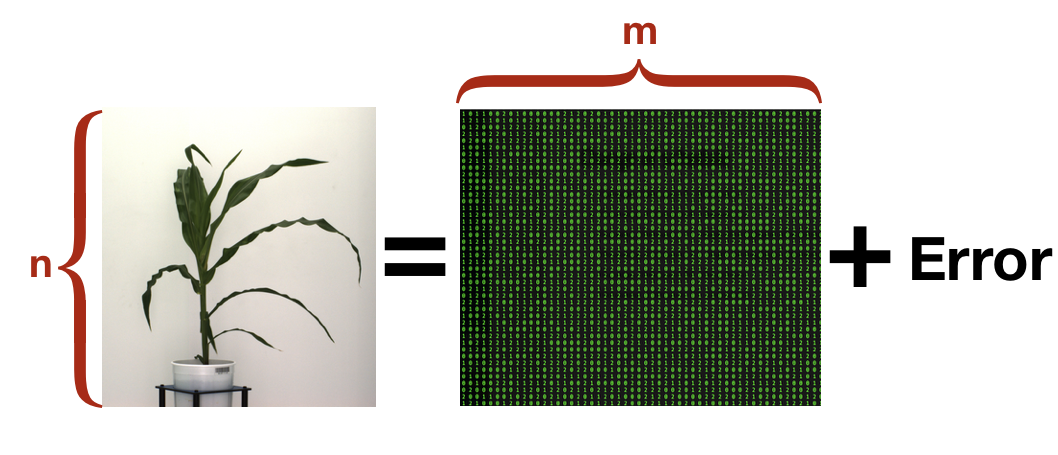 - `\(n\)`: number of individuals (records) - `\(m\)` number of SNPs (genetic markers) --- # Prediction vs. Inference Complex traits are controlled by large number of genes with small effects, and influenced by both genetics and environments - Inference (location) - average effects of allele substitution - Inference (variability) - variance component estimation - genomic heritability Combination of above two (e.g., estimate proportion of additive genetic variance explained by QTLs) - Prediction - genomic selection - prediction of yet-to-be observed phenotypes --- # Prediction vs. Inference <div align="center"> <img src="Lo2015PNAS.png" width=900 height=400> </div> * [http://www.pnas.org/content/112/45/13892.abstract ](http://www.pnas.org/content/112/45/13892.abstract ) --- # GWAS vs. Prediction  .right[[Wikimedia Commons](https://commons.wikimedia.org/wiki/File:Manhattan_Plot.png)] --- # How to parameterize response variable y? - Prediction of additive genetic effects - `\(\mathbf{ y = E + a + \boldsymbol{\epsilon}}\)` - Prediction of total genetic effects **parametrically** - `\(\mathbf{ y = \mathbf{E} + \underbrace{\mathbf{ a + d + a*a + a*d + d*d}}_{g} + } \boldsymbol{\epsilon}\)` - Prediction of total genetic effects **non-parametrically** - `\(\mathbf{ y = \mathbf{E} + \mathbf{g} + \boldsymbol{\epsilon}}\)` 1. Genomic selection 2. Genomic prediction 3. Phenotypic prediction --- # What is quantitative genetics? -- Population genetics - **Mathematics** is language of population genetics, **population genetics** is language of **evolution**. -- Quantitative genetics - **Statistics** is language of quantitative genetics, **quantitative genetics** is language of **complex trait genetics**. -- **Phenotypes** first in quantitative genetics In the era of genomics, phenotype is **king** <center> <iframe src="https://giphy.com/embed/9ADoZQgs0tyww" width="400" height="200" frameBorder="0" class="giphy-embed" allowFullScreen></iframe><p><a href="https://giphy.com/gifs/obama-awesome-statistics-9ADoZQgs0tyww">via GIPHY</a></p> </center> --- # Genomic prediction - use all available markers  .center[[Meuwissen et al. (2001)](http://www.genetics.org/content/157/4/1819)] .pull-left[ - Genomic selection - Genome-enabled selection - Genome-assisted selection - Genomic prediction - Genome-enabled prediction - Genome-assisted prediction ] .pull-right[ - generation interval - prediction performance ] --- # How genomic selection works? <div align="center"> <img src="gsNRG.png" width=900 height=400> <p><a href="https://www.nature.com/articles/nrg2575"> Goddard and Hayes (2009) </a></p> </div> --- # Genomic selection vs. Marker assisted selection <div align="center"> <img src="nakayaIsobe.png" width=600 height=400> <p><a href="https://academic.oup.com/aob/article/110/6/1303/110713"> Nakaya and Isobe (2012)</a></p> </div> --- # How to evaluate prediction performance Cross-validation - take model uncertainty into account - divide data into training and testing sets - train the model in the training set - evaluate predictive performance in the testing set - predictive correlation: `\(r = cor(\mathbf{y}, \hat{\mathbf{y}})\)` - predictive correlation squared: `\(R^2 = cor(\mathbf{y}, \hat{\mathbf{y}})^2\)` - mean-squared error: `\(\sum(y - \hat{y})^2/n_{test}\)` --- # Forward validation 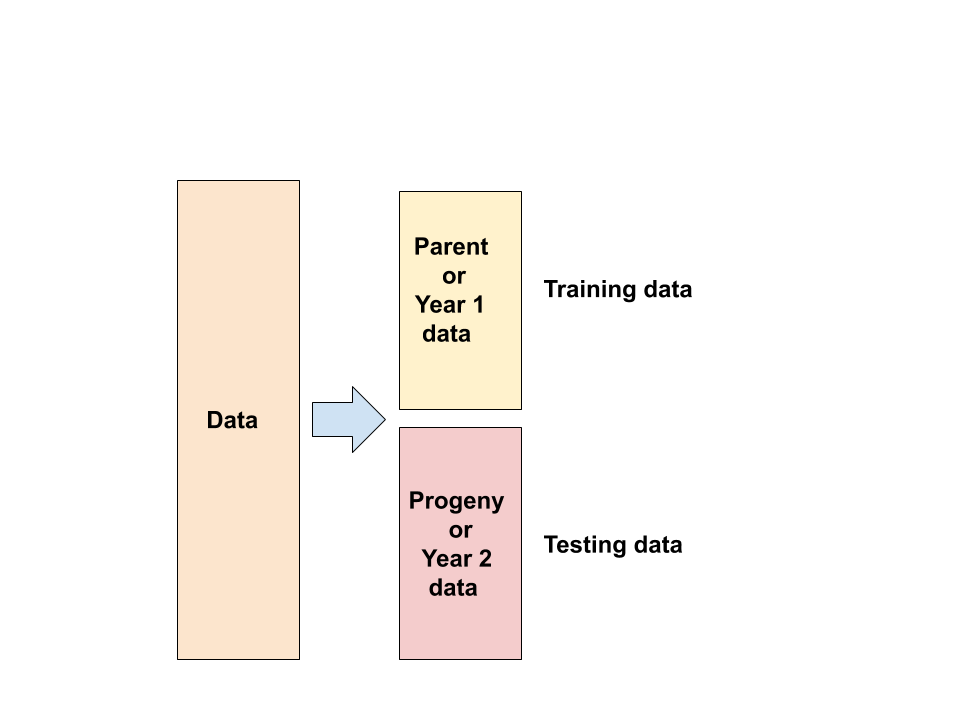 --- # Two-fold validation Repeat this process many times (e.g., 10) 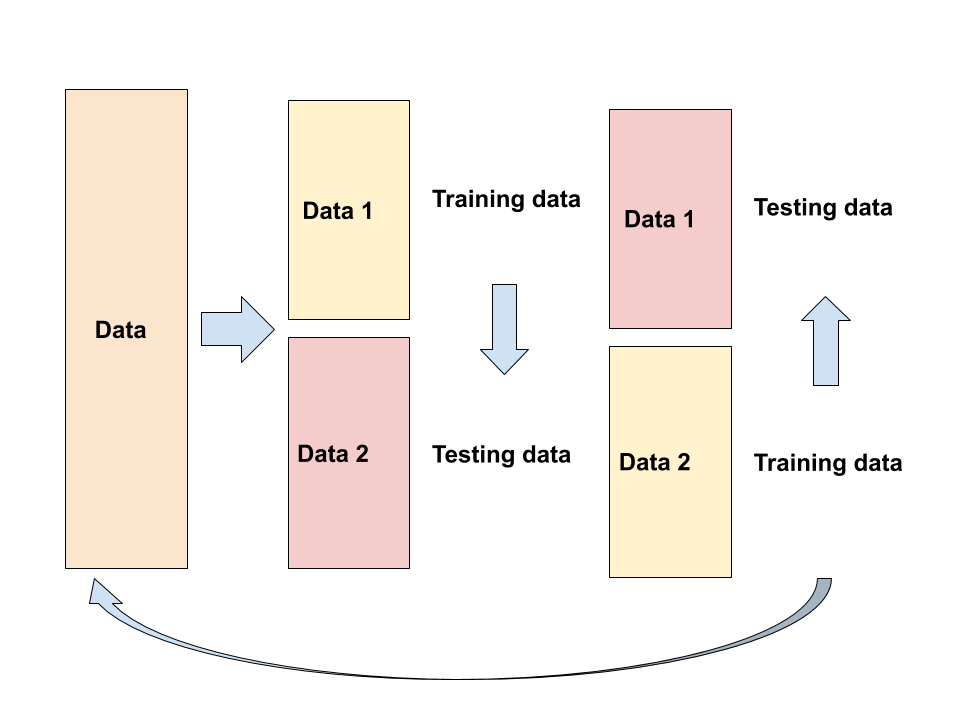 --- # Three-fold validation Repeat this process many times (e.g., 10) 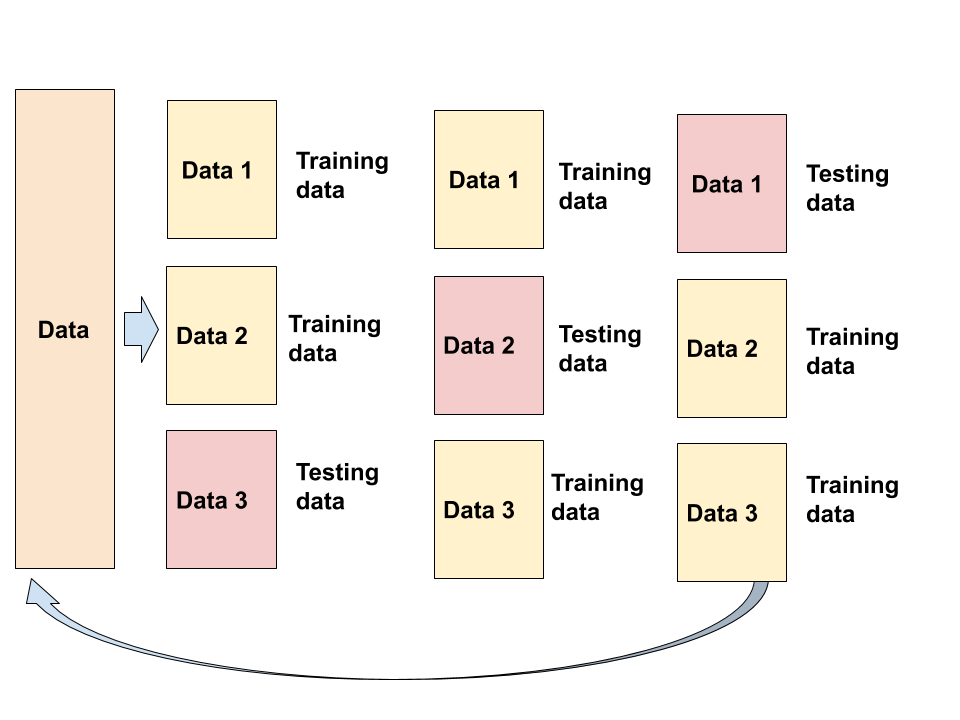 --- # k-fold validation - two-fold cross-validation - five-fold cross-validation - ten-fold cross-validation --- # Ordinary least squares (OLS) Quantitative genetic model: `\(\mathbf{y} = \mathbf{Wa} + \boldsymbol{\epsilon}\)` How to find the SNP effects ( `\(\mathbf{a}\)` )? -- We minimize the residual sum of squares `\begin{align*} \boldsymbol{\epsilon}' \boldsymbol{\epsilon} &= (\mathbf{y-Wa})'(\mathbf{y-Wa}) \\ &= \mathbf{y}'\mathbf{y} - \mathbf{y}'\mathbf{W} \mathbf{a}- \mathbf{a}'\mathbf{W}'\mathbf{y} + \mathbf{a}'\mathbf{W}'\mathbf{W}\mathbf{a} \\ &= \mathbf{y}'\mathbf{y} - 2\mathbf{a}'\mathbf{W}'\mathbf{y} + \mathbf{a}'\mathbf{W}'\mathbf{W}\mathbf{a} \end{align*}` We take a partial derivative with respect to `\(\mathbf{a}\)` `\begin{align*} \frac{\partial \boldsymbol{\epsilon\epsilon}'}{\partial \boldsymbol{a}} &= 2 \mathbf{W}'\mathbf{W} \mathbf{a} - 2\mathbf{X}'\mathbf{y} \end{align*}` By setting the equation equal to zero, we obtain a least square estimator of `\(\mathbf{a}\)`. `\begin{align*} \mathbf{W}'\mathbf{W} \mathbf{a} &= \mathbf{W}' \mathbf{y} \\ \hat{\mathbf{a}} &= (\mathbf{W}'\mathbf{W})^{-1} \mathbf{W}' \mathbf{y} \end{align*}` --- # Ordinary least squares (OLS) - `\(\hat{\mathbf{a}}\)` is the vector of regression coefficient for markers, i.e., effect size of SNPs - if the Gauss-Markov theorem is met, `\(E[\hat{\mathbf{a}}] = \mathbf{a} \rightarrow\)` BLUE - `\(E[\boldsymbol{\epsilon}] = 0\)`, `\(Var[\boldsymbol{\epsilon}] = \mathbf{I}\sigma^2_{\epsilon}\)` What if number of SNPs ( `\(m\)` ) `\(>>\)` number of individuals ( `\(n\)` ) ??? -- - `\((\mathbf{W}'\mathbf{W})^{-1}\)` does not exist - Effective degrees of freedom --- class: inverse, center, middle # Genomic BLUP --- # Genomic best linear unbiased prediction Suppose underlying signal is given by $$ \mathbf{y} = \mathbf{g} + \boldsymbol{\epsilon} $$ where `\(\mathbf{g} \sim N(0, \mathbf{G}\sigma^2_g)\)`. We approximate the vector of genetic values `\(\mathbf{g}\)` with a linear function $$ \mathbf{y} = \mathbf{W}\mathbf{a} + \boldsymbol{\epsilon} $$ - `\(\mathbf{W}\)` is the centered `\(n\)` `\(\times\)` `\(m\)` matrix of additive marker genotypes - `\(\mathbf{a}\)` is the vector of regression coefficients on marker genotypes - `\(\boldsymbol{\epsilon}\)` is the residual --- # Genomic best linear unbiased prediction Variance-covariance matrix of `\(\mathbf{y}\)` is `\begin{align*} \mathbf{V}_y &= \mathbf{V}_g + \mathbf{V}_{\epsilon} \\ &= \mathbf{WW'}\sigma^2_{a} + \mathbf{I} \sigma^2_{\epsilon} \end{align*}` - `\(\mathbf{a} \sim N(0, \mathbf{I}\sigma^2_{\mathbf{a}})\)` - `\(\boldsymbol{\epsilon} \sim N(0, \mathbf{I}\sigma^2_{\boldsymbol{\epsilon}})\)` - `\(\mathbf{V}_g = \mathbf{WW'}\sigma^2_{a}\)` is the covariance matrix due to markers --- # Genomic best linear unbiased prediction If normality is assumed, the best linear unbiased prediction (BLUP) of `\(\mathbf{g}\)` `\((\hat{\mathbf{g}})\)` is the conditional mean of `\(\mathbf{g}\)` given the data `\begin{align} BLUP(\hat{\mathbf{g}}) &= E(\mathbf{g}|\mathbf{y}) = E[\mathbf{g}] + Cov(\mathbf{g}, \mathbf{y}^T) Var(\mathbf{y})^{-1} [\mathbf{y} - E(\mathbf{y})] \notag \\ &= Cov(\mathbf{W}\mathbf{a}, \mathbf{y}^T)\cdot \mathbf{V}_y^{-1} \mathbf{y} \notag \\ &= \mathbf{WW'}\sigma^2_{\mathbf{a}} [\mathbf{WW'}\sigma^2_{a} + \mathbf{I} \sigma^2_{\epsilon}]^{-1} \mathbf{y} \notag \\ &= [\mathbf{I} + \frac{\sigma^2_{\epsilon}}{\mathbf{WW'}\sigma^2_{a}} ]^{-1} \mathbf{y} \\ &= [\mathbf{I} + (\mathbf{WW'})^{-1} \frac{\sigma^2_{\epsilon}}{\sigma^2_{a}} ]^{-1} \mathbf{y}, \end{align}` assuming that `\(\mathbf{WW'}\)` is invertible - `\(Cov(\mathbf{W}) = \mathbf{WW'}\)` is a covariance matrix of marker genotypes (provided that `\(X\)` is centered), often considered to be the simplest form of additive genomic relationship kernel, `\(\mathbf{G}\)`. --- # Genomic best linear unbiased prediction We can refine this kernel `\(Cov(\mathbf{W}) = \mathbf{WW'}\)` by relating genetic variance `\(\sigma^2_g\)` and marker genetic variance `\(\sigma^2_{a}\)` under the following assumptions Assume genetic value is parameterized as `\(g_{i} = \sum w_{ij} a_j\)` where both `\(x\)` and `\(a\)` are treated as random and independent. Assuming linkage equilibrium of markers (all loci are mutually independent) `\begin{align*} \sigma^2_g &= \sum_j 2 p_j(1-p_j) \cdot \sigma^2_{a_j}. \notag \\ \end{align*}` Under the homogeneous marker variance assumption `\begin{align} \sigma^2_{a} &= \frac{\sigma^2_g}{2 \sum_j p_j(1-p_j) }. \end{align}` --- # Genomic best linear unbiased prediction Recall that `\begin{align} BLUP(\hat{\mathbf{g}}) &= [\mathbf{I} + (\mathbf{WW'})^{-1} \frac{\sigma^2_{\epsilon}}{\sigma^2_{a}} ]^{-1} \mathbf{y}, \end{align}` Replacing `\(\sigma^2_{a}\)` we get `\begin{align} BLUP(\hat{\mathbf{g}}) &= \left [\mathbf{I} + (\mathbf{WW'})^{-1} \frac{\sigma^2_{\epsilon}}{ \frac{ \sigma^2_{g}}{2 \sum_j p_j(1-p_j)}} \right ]^{-1} \mathbf{y} \notag \\ &= \left [\mathbf{I} + \mathbf{G}^{-1} \frac{\sigma^2_{\epsilon}}{ \sigma^2_g} \right ]^{-1} \mathbf{y} \end{align}` where `\(\mathbf{G} = \frac{\mathbf{WW'}}{2 \sum_j p_j(1-p_j)}\)` is known as the first `\(\mathbf{G}\)` matrix introduced in VanRaden (2008) --- class: inverse, center, middle # Ridge regression BLUP --- ## BLUP of marker effects Suppose that the phenotype-genotype mapping function is `\begin{align*} \mathbf{y} &= \mathbf{g} + \boldsymbol{\epsilon} \\ \mathbf{y} &= \mathbf{W}\mathbf{a} + \boldsymbol{\epsilon} \\ \mathbf{a} &\sim N(0, \mathbf{I}\sigma^2_{a}) \end{align*}` The conditional expectation of `\(\mathbf{a}\)` given `\(\mathbf{y}\)` is `\begin{align*} BLUP(\mathbf{a}) &= E(\mathbf{a}| \mathbf{y})= Cov(\mathbf{a}, \mathbf{y})Var(\mathbf{y})^{-1} [\mathbf{y} - E(\mathbf{y})] \\ &= Cov(\mathbf{a}, \mathbf{W}\mathbf{a}) [\mathbf{W}\mathbf{W'} \sigma^2_{\mathbf{a}}+ \mathbf{I}\sigma^2_{\boldsymbol{\epsilon}}]^{-1} \mathbf{y} \\ &= \sigma^2_{\mathbf{a}} \mathbf{W}' [\mathbf{W}\mathbf{W'} \sigma^2_{\mathbf{a}} + \mathbf{I}\sigma^2_{\boldsymbol{\epsilon}}]^{-1} \mathbf{y} \\ &= \sigma^2_{\mathbf{a}} \mathbf{W'} (\mathbf{W}\mathbf{W'})^{-1} [ \sigma^2_{\mathbf{a}}\mathbf{I} + (\mathbf{W}\mathbf{W'})^{-1} \sigma^2_{\boldsymbol{\epsilon}}]^{-1} \mathbf{y} \\ &= \mathbf{W}^T (\mathbf{W}\mathbf{W'})^{-1} [ \mathbf{I} + (\mathbf{W}\mathbf{W'})^{-1} \frac{\sigma^2_{\boldsymbol{\epsilon}}}{\sigma^2_{\mathbf{a}}} ]^{-1} \mathbf{y}. \end{align*}` Alternatively, `\begin{align*} BLUP(\mathbf{a}) &= \mathbf{W}^T [ (\mathbf{W}\mathbf{W'}) + \frac{\sigma^2_{\boldsymbol{\epsilon}}}{\sigma^2_{\mathbf{a}}}\mathbf{I} ]^{-1} \mathbf{y}. \end{align*}` --- # BLUP of marker effects Thus, `\begin{align*} BLUP(\mathbf{a}) &= \mathbf{W}^T (\mathbf{W}\mathbf{W'})^{-1} [ \mathbf{I} + (\mathbf{W}\mathbf{W'})^{-1} \frac{\sigma^2_{\boldsymbol{\epsilon}}}{\sigma^2_{\mathbf{a}}} ]^{-1} \mathbf{y} \\ &= \mathbf{W'} (\mathbf{W}\mathbf{W'})^{-1} BLUP(\mathbf{g}). \end{align*}` Thus, once we obtain `\(\hat{\mathbf{g}}\)` from GBLUP, BLUP of marker coefficients is given by `\(\hat{\mathbf{a}} = \mathbf{W'} (\mathbf{W}\mathbf{W'})^{-1} \hat{\mathbf{g}}\)` We arrive at the same prediction regardless of whether we start from the genotype matrix `\(\mathbf{W}\)` or from `\(\mathbf{g}\)` --- # Summary - GBLUP `\begin{align*} \mathbf{y} &= \mathbf{g} + \boldsymbol{\epsilon} \\ \mathbf{g} &\sim N(0, \mathbf{G}\sigma^2_g) \\ \mathbf{G} &= \frac{\mathbf{WW'}}{2 \sum_j p_j(1-p_j)} \end{align*}` - RR-BLUP `\begin{align*} \mathbf{y} &= \mathbf{g} + \boldsymbol{\epsilon} \\ \mathbf{y} &= \mathbf{W}\mathbf{a} + \boldsymbol{\epsilon} \\ \mathbf{a} &\sim N(0, \mathbf{I}\sigma^2_{a}) \end{align*}` - GBLUP and RR-BLUP `\begin{align*} BLUP(\mathbf{a}) &= \mathbf{W'} (\mathbf{W}\mathbf{W'})^{-1} BLUP(\mathbf{g}). \end{align*}` -- Assumption about marker effects? --- # Cross-validation for RRBLUP Training and testing sets partitioning `\begin{align*} \text{Training} &\in (\mathbf{y}_{trn},\mathbf{W}_{trn} ) \\ \text{Testing} &\in (\mathbf{y}_{tst},\mathbf{W}_{tst} ) \\ \mathbf{y}_{trn} &= \mathbf{W}_{trn} \hat{\mathbf{a}}_{trn} + \mathbf{e}_{trn} \\ \end{align*}` How to do a cross-validation? -- `\begin{align*} \hat{\mathbf{g}}_{tst} &= \mathbf{W}_{tst} \hat{\mathbf{a}}_{trn} \end{align*}` -- Then evaluate `\begin{align*} Cor(\mathbf{y}_{tst}, \hat{\mathbf{g}}_{tst}) = Cor(\mathbf{y}_{tst}, \mathbf{W}_{tst} \hat{\mathbf{a}}_{trn} ) \end{align*}` --- # Cross-validation for GBLUP Training and testing sets partitioning `\begin{align*} \mathbf{y}_{trn} &= \mathbf{g}_{trn} + \mathbf{e}_{trn} \\ \mathbf{g}_{trn} &\sim N(0, \mathbf{G}_{trn, trn}) \\ \mathbf{y}_{tst} &= \mathbf{g}_{tst} + \mathbf{e}_{trn} \\ \mathbf{g}_{tst} &\sim N(0, \mathbf{G}_{tst, tst}) \\ \end{align*}` How to do a cross-validation? -- Compute BLUP of `\(\mathbf{g}_{tst}\)` given `\(\hat{\mathbf{g}}_{trn}\)` `\begin{align*} BLUP(\mathbf{g}_{tst}) &= E(\mathbf{g}_{tst}|\hat{\mathbf{g}}_{trn}) \\ &= Cov(\mathbf{g}_{tst}, \hat{\mathbf{g}}_{trn}) Var(\hat{\mathbf{g}}_{trn})^{-1} [\hat{\mathbf{g}}_{trn} - E(\hat{\mathbf{g}}_{trn})] \\ &= \mathbf{G}_{tst, trn}\sigma^2_{g} \mathbf{G}_{trn, trn}^{-1} \sigma^{-2}_g \hat{\mathbf{g}}_{trn} \\ &= \mathbf{G}_{tst, trn} \mathbf{G}_{trn, trn}^{-1} \hat{\mathbf{g}}_{trn} \\ \end{align*}` -- Then evaluate `\begin{align*} Cor(\mathbf{y}_{tst}, \hat{\mathbf{g}}_{tst}) = Cor(\mathbf{y}_{tst}, \mathbf{G}_{tst, trn} \mathbf{G}_{trn, trn}^{-1} \hat{\mathbf{g}}_{trn}) \end{align*}` --- class: inverse, center, middle # Interactive deterministic formulas for genomic prediction --- # Shiny - [https://shiny.rstudio.com/](https://shiny.rstudio.com/) - A web application framework for **interactive** visualization - Able to generate user friendly web interfaces - Built on a reactive programming model - Entirely extensible - custom inputs and outputs - CSS themes - JavaScript and D3.js - Example - [Collision Detection](https://bl.ocks.org/mbostock/raw/3231298/) --- # Shiny framework <img src="Shinyframework.png" height="300px" width="650px"/> **Template** ```r library(shiny) ui <- fluidPage() server <- function(input, output) {} shinyApp(ui = ui, server = server) ``` --- # Control widgets <img src="widgets.png" width=700 height=470> .left[[RStudio](https://shiny.rstudio.com/tutorial/written-tutorial/lesson3/)] --- # Cross-validation for genomic prediction <div align="center"> <img src="Fig1CV.png" width=650 height=450> </div> .right[[doi:10.1093/jas/sky014](http://dx.doi.org/10.1093/jas/sky014)] --- # Deterministic genomic prediction formulas - highlight the relationships among prediction accuracy and potential factors influencing prediction accuracy - no computationally intensive cross-validation 1) **Population parameter-based deterministic formulas** - genotypes of individuals are not required 2) **Relationship-based deterministic formulas** - genotypes of individuals need to be known --- class: inverse, left, middle # ShinyGPAS - Shiny Genomic Prediction Accuracy Simulator Can be used for - _interactive_ exploration of potential factors influencing prediction accuracy - simulation of achievable prediction accuracy - prior to genotyping individuals or performing CV - supporting in-class teaching - no knowlege of R, HTML, JavaScript, or CSS is required. R code encapsulated as a web-based Shiny application Available at [https://chikudaisei.shinyapps.io/shinygpas/](https://chikudaisei.shinyapps.io/shinygpas/) and [https://github.com/morota/ShinyGPAS](https://github.com/morota/ShinyGPAS) --- class: inverse, center, middle # Population parameter-based deterministic formulas --- # Deterministic formula (1) Daetwyler et al. (2008; 2010) `\begin{align} r &= \sqrt{\frac{N h^2}{N h^2 + M_e} } \end{align}` where `\(N\)` is the number of individuals in the reference population, `\(h^2\)` is the heritability, and `\(M_e\)` is the number of independent chromosome segments. - treating genetic markers as fixed - independence of quantitative trait loci (QTL) - regression of phenotypes on genotype one locus at a time - `\(\sigma^2_{\epsilon}\)` and `\(\sigma^2_g + \sigma^2_{\epsilon}=1\)` - identical accuracy of QTL effect size estimates across QTL allele frequencies - perfect linkage disequilibrium (LD) between marker and QTL pairs - unrelated individuals --- # Deterministic formula (2) Goddard (2009) `\begin{align} r &= \sqrt{1 - \frac{\lambda}{2N\sqrt{\alpha}} \ln\left( \frac{1 + \alpha + 2\sqrt{\alpha}}{1 + \alpha - 2\sqrt{\alpha}}\right) } \end{align}` where `\(\lambda\)` is `\(M_e/(h^2\ln(2N_e))\)` and `\(\alpha\)` is `\(1 + 2(M_e/Nh^2\ln(2N_e))\)` - treating markers as random - assuming complete LD between marker and QTL pairs - QTL effects were assumed to be sampled from a normal distribution - assumes that QTL with high minor allele frequencies have more accurate effect size than QTL with low minor allele frequencies --- # Deterministic formula (3) Goddard et al. (2011) `\begin{align} r &= \sqrt{b \frac{Nbh^2/M_e}{1 + Nbh^2/M_e}} \end{align}` where `\(b = M/(M + M_e)\)` is the proportion of genetic variance explained by the markers and `\(M\)` is the is the number of markers. - accounts for incomplete LD between markers and QTL --- # Deterministic formula (4) Rabier et al. (2016) `\begin{align*} r &= \sqrt{\frac{h^2/(1-h^2)}{M_e/N + h^2/(1-h^2)}}. \end{align*}` - relaxing the assumption of `\(\sigma^2_{\epsilon}\)` and `\(\sigma^2_g + \sigma^2_{\epsilon}=1\)` - can be applied with any value of `\(\sigma^2_{\epsilon}\)` and `\(\sigma^2_g\)` --- # Deterministic formula (5) Rabier et al. (2016) `\begin{align*} r &= \sqrt{\frac{h^2/(1-h^2)}{\mathbb{E}(||\mathbf{x}'_{n_{\text{TRN} + 1}} \mathbf{X}'\mathbf{V}^{-1} ||^2) + h^2/(1-h^2)}} \end{align*}` `\(M_e/N\)` is equal to `\(\mathbb{E}(||\mathbf{x}'_{n_{\text{TRN} + 1}} \mathbf{X}'\mathbf{V}^{-1} ||^2)\)` under RRBLUP. - `\(\mathbf{x}'_{n_{\text{TRN} + 1}}\)` is the vector of markers belonging to the testing set individual - `\(\mathbf{X}\)` is the training set allele content matrix - `\(\mathbf{V} = \mathbf{X}\mathbf{X}' + \lambda \mathbf{I}\)` - `\(\lambda\)` is the regularization parameter - `\(||.||^2\)` is the squared norm Note that if we can assume individuals in training and testing sets were sampled from the same population, `\(\hat{\mathbb{E}}(||\mathbf{x}'_{n_{\text{TRN} + 1}} \mathbf{X}'\mathbf{V}^{-1} ||^2) \le 1\)` --- # Deterministic formula (6) de los Campos et al. (2013) Under the genomic best linear unbiased prediction framework `\begin{align} r &= \sqrt{ [1 - (1 - b)^2] h^2 } \end{align}` - assuming that the patterns of allele sharing between markers and causal loci are different - `\(b\)` is the average regression coefficient of the marker-based genomic relationships on genomic relationships at QTL --- # Deterministic formula (7) - Karaman et al. (2016) `\begin{align} r &= \sqrt{ h^2_M \left[ \frac{N h^2_M}{N h^2_M + M_e} \right] } \end{align}` - correlation between phenotypes and estimated breeding values (additive genetic values) - `\(h^2_M\)` is the genomic heritability, which is the proportion of phenotypic variance that is explained by regression on markers. --- # Deterministic formula (8) - Wientjes et al. (2016) `\begin{align} r = \sqrt{ \begin{bmatrix} b_{AC} r_{G_{AC}} \sqrt{\frac{h^2_A}{M_{e_{A,C}}} } & b_{BC} r_{G_{BC}} \sqrt{\frac{h^2_B}{M_{e_{B,C}}}} \end{bmatrix} \begin{bmatrix} \frac{h^2_A}{M_{e_{A,C}}} + \frac{1}{N_A} & r_{G_{AB}} \sqrt{\frac{h^2_A h^2_B}{M_{e_{A,C}} M_{e_{B,C}} } } \\ r_{G_{AB}} \sqrt{\frac{h^2_A h^2_B}{M_{e_{A,C}} M_{e_{B,C}} } } & \frac{h^2_B}{M_{e_{B,C}}} + \frac{1}{N_B} \end{bmatrix}^{-1} } \\ \times \sqrt{\begin{bmatrix} b_{AC} r_{G_{AC}} \sqrt{\frac{h^2_A}{M_{e_{A,C}}}} \\ b_{BC} r_{G_{BC}} \sqrt{\frac{h^2_B}{M_{e_{B,C}}}} \end{bmatrix}} \end{align}` Combines two populations A and B to predict prediction accuracy in population C. - `\(b_{AC}\)` is the square root of the proportion of the genetic variance in predicted population C explained by the markers in training population A - `\(r_{G_{AC}}\)` is the genetic correlation between populations A and C - `\(M_{e_{A,C}}\)` is the effective number of chromosome segments shared between populations A and C --- # Paper <img src="GSE.png" height="420px" width="710px"/> [doi:10.1186/s12711-017-0368-4](https://doi.org/10.1186/s12711-017-0368-4) --- class: inverse, center, middle # Relationship-based deterministic formulas --- ## Relationship-based deterministic formula (1) * use genotypes of selection candidates and reference individuals * accounts for family structures [VanRaden (2008)](https://doi.org/10.3168/jds.2007-0980) - selection index theory * accuracy of genomic prediction for each testing set individual (rather than the entire testing set individuals as seen in the population-parameter deterministic formuals) `\begin{align} r &= \sqrt{ \mathbf{c} \left [ \mathbf{G} + \mathbf{I} \frac{\sigma^2_{\epsilon}}{\sigma^2_g} \right ]^{-1} \mathbf{c}' } \end{align}` - `\(\mathbf{c}\)` is a vector of genomic relationships between the testing set individual and the reference population - `\(\mathbf{G}\)` is the genomic relationships among the reference population individuals --- ## Relationship-based deterministic formula (2) [Wientjes et al. (2015)](https://doi.org/10.1186/s12711-014-0086-0) - extended to across-population genomic prediction * predict an individual in population C from populations A and B `\begin{align} r = \sqrt{ \begin{bmatrix} r_{G_{AC}}\mathbf{c}_{AC} & r_{G_{BC}}\mathbf{c}_{BC} \end{bmatrix} \begin{bmatrix} \mathbf{G}_A + \mathbf{I}_A\frac{\sigma^2_{e_{a}}}{\sigma^2_{g_{a}}} & r_{G_{AB}}\mathbf{c}_{AB} \\ r_{G_{AB}}\mathbf{c}_{AB}' & \mathbf{G}_B + \mathbf{I}_B\frac{\sigma^2_{e_{b}}}{\sigma^2_{g_{b}}} \end{bmatrix}^{-1} } \\ \times \sqrt{ \begin{bmatrix} r_{G_{AC}}\mathbf{c}_{AC}' \\ r_{G_{BC}}\mathbf{c}_{BC}' \end{bmatrix}} \end{align}` * predict an individual in population C from population A `\begin{align} r &= \sqrt{ r_{G_{AC}}\mathbf{c}_{AC} \left [ \mathbf{G}_{A} + \mathbf{I}_{A} \frac{\sigma^2_{e_{a}}}{\sigma^2_{g_{a}}} \right ] r_{G_{AC}}\mathbf{c}_{AC}' } \end{align}` - --- # Assumption about marker effects - BLUP assumes normally distributed QTL / marker effects - Does not match the prior information regarding the distributions of QTL / marker effects for some traits - What if we want to assume QTL / markers have non-Gaussian distribution? --- # Function f(.) Search for a function `\(\mathbf{y} \leftarrow f(\mathbf{W})\)` that can deal with - dimensionality - number of SNP (m) > number of individuals (n) - complexity - flexible with respect to type of input data (e.g., gene action) --- # Penalized regression Treat markers as fixed effect `\begin{align*} \mathbf{y} &= \mathbf{Wa} + \boldsymbol{\epsilon} \end{align*}` Penalty function: `\(\mathbf{J}(\mathbf{a})\)`, Smoothing parameter: `\(\lambda\)` `\begin{align*} \mathbf{a} &= argmin_{a}[(\mathbf{y} - \mathbf{Wa})' (\mathbf{y} - \mathbf{Wa}) + \lambda \mathbf{J}( \mathbf{a} )] \end{align*}` Ridge regression (L2 penalty) - `\(\mathbf{J}( \mathbf{a} ) = \sum_{j=1}^{m}a_{j}^2 \rightarrow\)` `\(\hat{\mathbf{a}}_{ridge} = (\mathbf{W}'\mathbf{W}) + \lambda\mathbf{I})^{-1}\mathbf{W}'\mathbf{y}\)` - how to pick `\(\lambda\)`? LASSO (L1 penalty) - `\(\mathbf{J}(\mathbf{a}) = \sum_{j=1}^{m}|a_{j}| \rightarrow\)` no closed form --- # Bayes theorem `\begin{align*} \begin{cases} y: & \text{ observed data } y \sim p(y|\theta) \\ \theta : & \text{ parameters (all unobserved quantities) } \end{cases} \end{align*}` `\begin{align*} p(\theta | y) &= \frac{p(\theta, y)}{p(y)} \\ &= \frac{ p(y | \theta) p(\theta) }{ p(y) } \\ \underbrace{p(\theta | y)}_{posterior} &\propto \underbrace{p(y | \theta)}_{sampling \text{ } dis} \underbrace{p(\theta)}_{prior} \\ \end{align*}` - posterior = data (likelihood) x prior - `\(p(\theta | y) = f(y|\theta) \cdot p(\theta)\)` - all unknowns are treated as random - predictive distribution - assign a prior distribution for all unknowns - derive marginal or conditional posterior --- # Bayesian penalized regression `\(\lambda = \frac{\sigma^2_e}{\sigma^2_{a}}\)` Bayesian ridge regression `\begin{align*} \hat{a} &=_{argmin} \left[ (\mathbf{y} - \mathbf{W}\mathbf{a})'(\mathbf{y}- \mathbf{W} \mathbf{a}) + \lambda \mathbf{a}' \mathbf{I} \mathbf{a} \right] \\ &=_{argmax} \left[ - \frac{1}{2}(\mathbf{y} - \mathbf{W}\mathbf{a})'(\mathbf{y}- \mathbf{W} \mathbf{a}) - \frac{1}{2} \lambda \mathbf{a}' \mathbf{I} \mathbf{a} \right] \\ &=_{argmax} \left[ - \frac{1}{2 \sigma^2_e}(\mathbf{y} - \mathbf{W}\mathbf{a})'(\mathbf{y}- \mathbf{W} \mathbf{a}) - \frac{1}{2 \sigma^2_e} \lambda \mathbf{a}' \mathbf{I} \mathbf{a} \right] \\ &=_{argmax} \left[ - \frac{1}{2 \sigma^2_e}(\mathbf{y} - \mathbf{W}\mathbf{a})'(\mathbf{y}- \mathbf{W} \mathbf{a}) - \frac{1}{2 \sigma^2_{a}} \mathbf{a}' \mathbf{I} \mathbf{a} \right] \\ &=_{argmax} \exp \left \{ \left[ - \frac{1}{2 \sigma^2_e}(\mathbf{y} - \mathbf{W}\mathbf{a})'(\mathbf{y}- \mathbf{W} \mathbf{a}) - \frac{1}{2 \sigma^2_a} \mathbf{a}' \mathbf{I} \mathbf{a} \right] \right \} \\ &= \left [ \exp \left \{ - \frac{1}{2 \sigma^2_e}(\mathbf{y} - \mathbf{W}\mathbf{a})'(\mathbf{y}- \mathbf{W} \mathbf{a}) \right \} \exp \left \{ - \frac{1}{2 \sigma^2_{a}} \mathbf{a}' \mathbf{I} \mathbf{a} \right \} \right ] \end{align*}` This is proportional to `\(p(\mathbf{a}| \mathbf{y}, \sigma^2_e, \sigma^2_{a}) \propto p(\mathbf{y}|\mathbf{a}, \sigma^2_e) p(\mathbf{a}| \sigma^2_{a})\)`, that is, the posterior density of `\(\mathbf{a}\)` (given `\(\sigma^2_e\)` and `\(\sigma^2_{a}\)`) - `\(\boldsymbol{y}|\mathbf{a}, \sigma^2_e \sim N(\mathbf{W}\mathbf{a}, \mathbf{I}\sigma^2_e)\)` - `\(\mathbf{a}|\sigma^2_{a} \sim N(0, \mathbf{I} \sigma_{a}^2)\)` --- # Bayesian penalized regression `\(\tilde{\lambda} = \frac{\lambda}{2 \sigma^2_e}\)` Bayesian LASSO `\begin{align*} \hat{a} &=_{argmin} \left[ (\mathbf{y} - \mathbf{W}\mathbf{a})'(\mathbf{y}- \mathbf{W} \mathbf{a}) + \lambda | \mathbf{a}' \mathbf{I} | \right] \\ &=_{argmax} \left[ - \frac{1}{2}(\mathbf{y} - \mathbf{W}\mathbf{a})'(\mathbf{y}- \mathbf{W} \mathbf{a}) - \frac{\lambda}{2} | \mathbf{a} \mathbf{I}| \right] \\ &=_{argmax} \left[ - \frac{1}{2 \sigma^2_e}(\mathbf{y} - \mathbf{W}\mathbf{a})'(\mathbf{y}- \mathbf{W} \mathbf{a}) - \frac{ \lambda}{2 \sigma^2_e} | \mathbf{a} \mathbf{I} | \right] \\ &=_{argmax} \left[ - \frac{1}{2 \sigma^2_e}(\mathbf{y} - \mathbf{W}\mathbf{a})'(\mathbf{y}- \mathbf{W} \mathbf{a}) - \tilde{\lambda} | \mathbf{a} \mathbf{I} | \right] \\ &=_{argmax} \exp \left \{ \left[ - \frac{1}{2 \sigma^2_e}(\mathbf{y} - \mathbf{W}\mathbf{a})'(\mathbf{y}- \mathbf{W}\mathbf{a}) - \tilde{\lambda} \mathbf{a} \mathbf{I} \mathbf{a} \right] \right \} \\ &= \left [ \exp \left \{ - \frac{1}{2 \sigma^2_e}(\mathbf{y} - \mathbf{W}\mathbf{a})'(\mathbf{y}- \mathbf{W} \mathbf{a}) \right \} \exp \left \{ - \tilde{\lambda} | \mathbf{a} \mathbf{I} | \right \} \right ] \end{align*}` - Gaussian `\(\times\)` Double exponential --- # BayesRR (ridge regression) `\begin{align*} \mathbf{y} = \sum^m_{j=1} \mathbf{W}_{j} a_j + \epsilon \rightarrow \mathbf{y}| a_j, \sigma^2_e \sim N(\mathbf{W}_{j} a_j, \sigma^2_e) \end{align*}` `\(p(\mathbf{a}| \mathbf{y}, \sigma^2_e, \sigma^2_{a}) \propto p(\mathbf{y}|\mathbf{a}, \sigma^2_e) \cdot p(\mathbf{a}| \sigma^2_{a})\)` `\begin{align*} \text{Prior distributions} \begin{cases} a_j|\sigma^2_{a} \sim N(0, \sigma_{a}^{2} ) \\ \sigma^2_{a} \sim \chi^{-2}(\nu, S) \\ \sigma^2_{e} \sim \chi^{-2}(\nu, S) \end{cases} \end{align*}` - `\(\chi^{-2}(\nu, S) \rightarrow\)` scaled inverted chi-square distribution with `\(\nu\)` degrees of freedom and scale parameter `\(S\)` --- # BayesL (Lasso) `\begin{align*} \mathbf{y} = \sum^m_{j=1} \mathbf{W}_{j} a_j + \epsilon \rightarrow \mathbf{y}| a_j, \sigma^2_e \sim N(\mathbf{W}_{j} a_j, \sigma^2_e) \end{align*}` `\(p(\mathbf{a}| \mathbf{y}, \sigma^2_e, \sigma^2_{a}) \propto p(\mathbf{y}|\mathbf{a}, \sigma^2_e) \cdot p(\mathbf{a}| \sigma^2_{a})\)` `\begin{align*} \text{Prior distributions} \begin{cases} a_j|\sigma^2_{a_j} \sim N(0, \sigma_{a_j}^{2} ) \\ \sigma^2_{a_j} \sim Exponential(\lambda) \\ \sigma^2_{e} \sim \chi^{-2}(\nu, S) \end{cases} \end{align*}` --- # BayesA `\begin{align*} \mathbf{y} = \sum^m_{j=1} \mathbf{W}_{j} a_j + \epsilon \rightarrow \mathbf{y}| a_j, \sigma^2_e \sim N(\mathbf{W}_{j} a_j, \sigma^2_e) \end{align*}` `\(p(\mathbf{a}| \mathbf{y}, \sigma^2_e, \sigma^2_{a}) \propto p(\mathbf{y}|\mathbf{a}, \sigma^2_e) \cdot p(\mathbf{a}| \sigma^2_{a})\)` `\begin{align*} \text{Prior distributions} \begin{cases} a_j|\sigma^2_{a_j} \sim N(0, \sigma_{a_j}^{2} ) \\ \sigma^2_{a_j} \sim \chi^{-2}(\nu, S) \\ \sigma^2_{e} \sim \chi^{-2}(\nu, S) \end{cases} \end{align*}` - `\(\chi^{-2}(\nu, S) \rightarrow\)` scaled inverted chi-square distribution with `\(\nu\)` degrees of freedom and scale parameter `\(S\)` --- # BayesB `\begin{align*} \mathbf{y} = \sum^m_{j=1} \mathbf{W}_{j} a_j + \epsilon \rightarrow \mathbf{y}| a_j, \sigma^2_e \sim N(\mathbf{W}_{j} a_j, \sigma^2_e) \end{align*}` `\(p(\mathbf{a}| \mathbf{y}, \sigma^2_e, \sigma^2_{a}) \propto p(\mathbf{y}|\mathbf{a}, \sigma^2_e) \cdot p(\mathbf{a}| \sigma^2_{a})\)` `\begin{align*} \text{Prior distributions} \begin{cases} a_j|\sigma^2_{a_j} \sim N(0, \sigma_{a_j}^{2} ) \\ \begin{cases} \sigma^2_{a_j} = 0 \quad \text{with probability} \quad \pi\\ \sigma^2_{a_j} \sim \chi^{-2}(\nu, S) \quad \text{with probability} \quad (1 - \pi) \end{cases} \\ \sigma^2_{e} \sim \chi^{-2}(\nu, S) \end{cases} \end{align*}` - `\(\pi\)`: probability that markers have no effect - `\(\chi^{-2}(\nu, S) \rightarrow\)` scaled inverted chi-square distribution with `\(\nu\)` degrees of freedom and scale parameter `\(S\)` --- # BayesB* (modified version) `\begin{align*} \mathbf{y} = \sum^m_{j=1} \mathbf{W}_{j} a_j + \epsilon \rightarrow \mathbf{y}| a_j, \sigma^2_e \sim N(\mathbf{W}_{j} a_j, \sigma^2_e) \end{align*}` `\(p(\mathbf{a}| \mathbf{y}, \sigma^2_e, \sigma^2_{a}) \propto p(\mathbf{y}|\mathbf{a}, \sigma^2_e) \cdot p(\mathbf{a}| \sigma^2_{a})\)` `\begin{align*} \text{Prior distributions} \begin{cases} \begin{cases} a_j = 0 \quad \text{with probability} \quad \pi \\ a_j|\sigma^2_{a_j} \sim N(0, \sigma_{a_j}^{2} ) \quad \text{with probability} \quad (1 - \pi) \end{cases} \\ \sigma^2_{a_j} \sim \chi^{-2}(\nu, S) \\ \sigma^2_{e} \sim \chi^{-2}(\nu, S) \end{cases} \end{align*}` - `\(\pi\)`: probability that markers have no effect - `\(\chi^{-2}(\nu, S) \rightarrow\)` scaled inverted chi-square distribution with `\(\nu\)` degrees of freedom and scale parameter `\(S\)` --- # BayesB** (modified version) `\begin{align*} \mathbf{y} = \sum^m_{j=1} \mathbf{W}_{j} a_j + \epsilon \rightarrow \mathbf{y}| a_j, \sigma^2_e \sim N(\mathbf{W}_{j} a_j, \sigma^2_e) \end{align*}` `\(p(\mathbf{a}| \mathbf{y}, \sigma^2_e, \sigma^2_{a}) \propto p(\mathbf{y}|\mathbf{a}, \sigma^2_e) \cdot p(\mathbf{a}| \sigma^2_{a})\)` `\begin{align*} \text{Prior distributions} \begin{cases} \begin{cases} a_j|\sigma^2_{a_j} \sim N(0, \sigma_{a_j}^{2} \approx 0) \quad \text{with probability} \quad \pi \\ a_j|\sigma^2_{a_j} \sim N(0, \sigma_{a_j}^{2} ) \quad \text{with probability} \quad (1 - \pi) \end{cases} \\ \sigma^2_{a_j} \sim \chi^{-2}(\nu, S) \\ \sigma^2_{e} \sim \chi^{-2}(\nu, S) \end{cases} \end{align*}` - `\(\pi\)`: probability that markers have no effect - `\(\chi^{-2}(\nu, S) \rightarrow\)` scaled inverted chi-square distribution with `\(\nu\)` degrees of freedom and scale parameter `\(S\)` --- # BayesCpi `\begin{align*} \mathbf{y} = \sum^m_{j=1} \mathbf{W}_{j} a_j + \epsilon \rightarrow \mathbf{y}| a_j, \sigma^2_e \sim N(\mathbf{W}_{j} a_j, \sigma^2_e) \end{align*}` `\(p(\mathbf{a}| \mathbf{y}, \sigma^2_e, \sigma^2_{a}) \propto p(\mathbf{y}|\mathbf{a}, \sigma^2_e) \cdot p(\mathbf{a}| \sigma^2_{a})\)` `\begin{align*} \text{Prior distributions} \begin{cases} \begin{cases} a_j = 0 \quad \text{with probability} \quad \pi \\ a_j|\sigma^2_{a} \sim N(0, \sigma_{a}^{2} ) \quad \text{with probability} \quad (1 - \pi) \end{cases} \\ \pi \sim Uniform(0,1) \\ \sigma^2_{a} \sim \chi^{-2}(\nu, S) \\ \sigma^2_{e} \sim \chi^{-2}(\nu, S) \end{cases} \end{align*}` - `\(\pi\)`: probability that markers have no effect - `\(\chi^{-2}(\nu, S) \rightarrow\)` scaled inverted chi-square distribution with `\(\nu\)` degrees of freedom and scale parameter `\(S\)` --- # BayesC `\begin{align*} \mathbf{y} = \sum^m_{j=1} \mathbf{W}_{j} a_j + \epsilon \rightarrow \mathbf{y}| a_j, \sigma^2_e \sim N(\mathbf{W}_{j} a_j, \sigma^2_e) \end{align*}` `\(p(\mathbf{a}| \mathbf{y}, \sigma^2_e, \sigma^2_{a}) \propto p(\mathbf{y}|\mathbf{a}, \sigma^2_e) \cdot p(\mathbf{a}| \sigma^2_{a})\)` `\begin{align*} \text{Prior distributions} \begin{cases} \begin{cases} a_j = 0 \quad \text{with probability} \quad \pi \\ a_j|\sigma^2_{a} \sim N(0, \sigma_{a}^{2} ) \quad \text{with probability} \quad (1 - \pi) \end{cases} \\ \sigma^2_{a} \sim \chi^{-2}(\nu, S) \\ \sigma^2_{e} \sim \chi^{-2}(\nu, S) \end{cases} \end{align*}` - `\(\pi\)`: probability that markers have no effect - `\(\chi^{-2}(\nu, S) \rightarrow\)` scaled inverted chi-square distribution with `\(\nu\)` degrees of freedom and scale parameter `\(S\)` --- # Prior densities of a ([de los Campos et al., 2012](https://doi.org/10.1534/genetics.112.143313)) <img src="deloscampos2012.png" width=700 height=280> .pull-left[ - Bayes RR (ridge regression) - BayesL (LASSO) - BayesA - BayesB ] .pull-right[ - BayesB* - BayesB** - BayesC - BayesCpi ]